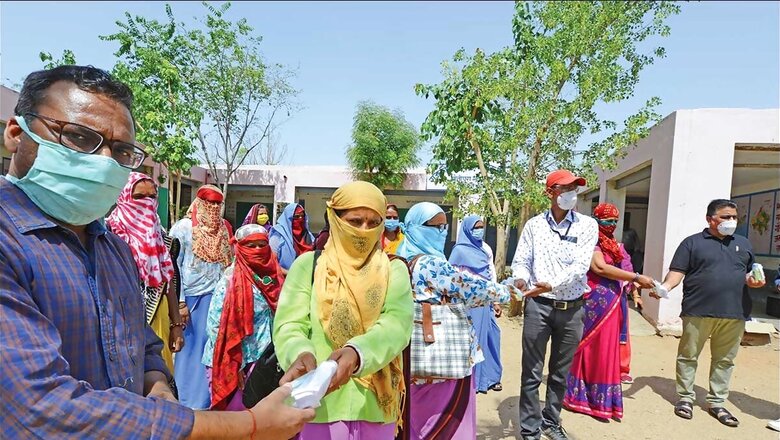
views
In many parts of the world, the monsoon season brings heavy rainfall and strong winds that can disrupt public infrastructure and services. One of the disruptions that hurt us most is the disruption to sanitation services. Public toilets, which provide a vital facility for millions of people, especially those who lack access to private toilets, can face various challenges during the monsoon season. The heavy, lashing rain of the monsoons can cause flooding, landslides, cyclones and other phenomena that can flood or otherwise damage public toilets, creating a situation where people dependent on these public toilets have nowhere to go.
This compromises the safety and hygiene of these populations, and poses serious health and social risks.
The Challenges Faced by Public Toilets During Monsoon
Public toilets can face several challenges during the monsoon season, such as:
Heavy rainfall leading to flooding and waterlogging
The excessive amount of water can inundate public toilets and cause damage to the toilet structures and plumbing systems. This can result in overflowing or clogged toilets, broken pipes, or leaking faucets. Moreover, flooding and waterlogging can create unhygienic conditions and breed mosquitoes and other disease-causing organisms.
Damage to toilet structures and plumbing systems:
The strong winds and rain can also damage the toilet structures and plumbing systems. For example, the roof or walls of the toilet building can collapse or crack, exposing the users to the elements. The electrical wiring or lighting fixtures can also be damaged or short-circuited, creating safety hazards.
Increased health risks due to poor sanitation conditions:
The poor sanitation conditions caused by the monsoon can increase the risk of infections and diseases for the users of public toilets. For instance, the contaminated water or surfaces can transmit diarrheal diseases, typhoid, cholera, or hepatitis. The lack of proper ventilation or lighting can also affect the air quality and visibility inside the toilets.
Impact on accessibility for individuals with disabilities:
The monsoon season can also affect the accessibility of public toilets for individuals with disabilities. For example, the flooded or slippery pathways can make it difficult or dangerous for wheelchair users or those with mobility impairments to reach the toilets. The damaged or inaccessible toilet fixtures or grab bars can also pose challenges for those who need assistance or support while using the toilets.
Ensuring Monsoon-Proofing for Public Toilets
To ensure that public toilets remain accessible and safe during the monsoon season, some of the measures that can be taken are:
Robust infrastructure design and construction:
The design and construction of public toilets should take into account the potential impact of the monsoon season.
- Proper site selection and elevation considerations: The location and height of public toilets should be chosen carefully to avoid low-lying or flood-prone areas. The toilets should also be elevated above the ground level to prevent water entry.
- Water-resistant materials and finishes: The materials and finishes used for public toilets should be water-resistant and durable. For example, concrete, brick, or metal can be used for the toilet structures, while ceramic, plastic, or stainless steel can be used for the toilet fixtures.
- Reinforced plumbing systems: The plumbing systems of public toilets should be reinforced and protected from water damage. For example, pipes should be buried underground or covered with waterproof materials. Faucets should have valves or taps that can be turned off when not in use.
Adequate drainage and flood management:
The drainage and flood management of public toilets should be adequate and effective.
- Installation of effective drainage systems: The drainage systems of public toilets should be able to handle the excess water from rainfall or flooding. For example, gutters, pipes, or channels should be installed to divert water away from the toilet buildings.
- Regular maintenance and cleaning of drains: The drains of public toilets should be regularly maintained and cleaned to prevent blockages or clogs. For example, debris, trash, or sediment should be removed from the drains periodically.
Accessibility features for individuals with disabilities:
The accessibility features of public toilets should cater to the needs of individuals with disabilities.
- Wide entrance doors and pathways for wheelchair access: The entrance doors and pathways of public toilets should be wide enough to accommodate wheelchair users. The doors should also have handles or knobs that are easy to operate.
- Accessible toilet fixtures and grab bars: The toilet fixtures and grab bars of public toilets should be accessible and user-friendly for individuals with disabilities. For example, the toilet seats should be at an appropriate height and have lids that can be lifted easily. The grab bars should be sturdy and well-positioned.
- Non-slip flooring and proper lighting: The flooring and lighting of public toilets should be non-slip and proper for safety and visibility. For example, the flooring should have anti-skid or textured surfaces. The lighting should be bright and evenly distributed.
Education and Awareness as an Enabler
As with anything else, the first step is always education. It is only when our public servants, policy makers and local communities are all aware of a viable solution that it is possible to ask for it, and make it happen.
Harpic, which is India’s leading brand in the lavatory care segment, is deeply aware of this gap. Over the years, Harpic has built strong communication strategies around the need for good toilet hygiene habits in particular, and sanitation overall. Harpic decided to take the lead in the sanitation and hygiene movement by creating innovative, thought provoking campaigns and outreach programs.
Harpic has also partnered with News18 in the Mission Swachhta aur Paani Initiative, which has, for 3 years now, championed the cause of inclusive sanitation where everyone has access to clean toilets. It advocates equality for all genders, abilities, castes and classes and strongly believes that clean toilets are a shared responsibility.
Mission Swachhta aur Paani has also served as a valuable platform for enabling conversations between stakeholders from the government, NGOs and grassroots movements to come together and create sustainable solutions in the sphere of toilet access and sanitation for all. Additionally, Mission Swachhta aur Paani has created a reliable repository of information that empowers each of us to take actions that are within our power – be it educating our own children and those of our maids, lobbying local municipalities for monsoon proof toilets, or amplifying our messages on social media.
The Swachh Bharat Mission has shown us the power of combined action. Let’s use that momentum to create a society where all of us have dignity, safety and hygiene, irrespective of where we live, how much we earn, or what the weather looks like.
Join us here, to learn how you can make an impact.



















Comments
0 comment